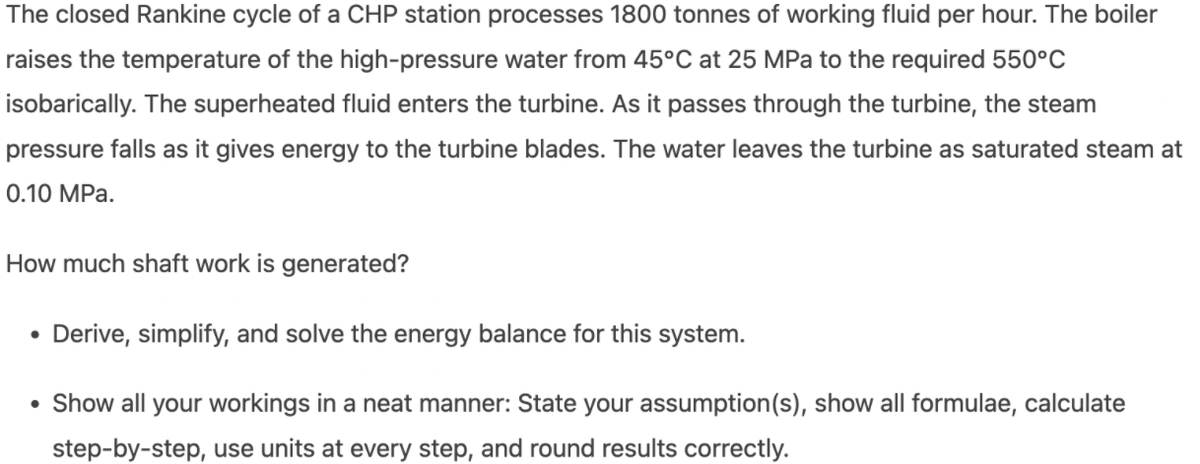The closed Rankine cycle of a CHP station processes 1800 tonnes of working fluid per hour. The boiler raises the temperature of the high-pressure water from 45°C at 25 MPa to the required 550°C isobarically. The superheated fluid enters the turbine. As it passes through the turbine, the steam pressure falls as it gives energy to the turbine blades. The water leaves the turbine as saturated steam at 0.10 MPa. How much shaft work is generated? • Derive, simplify, and solve the energy balance for this system. • Show all your workings in a neat manner: State your assumption(s), show all formulae, calculate step-by-step, use units at every step, and round results correctly.
The closed Rankine cycle of a CHP station processes 1800 tonnes of working fluid per hour. The boiler raises the temperature of the high-pressure water from 45°C at 25 MPa to the required 550°C isobarically. The superheated fluid enters the turbine. As it passes through the turbine, the steam pressure falls as it gives energy to the turbine blades. The water leaves the turbine as saturated steam at 0.10 MPa. How much shaft work is generated? • Derive, simplify, and solve the energy balance for this system. • Show all your workings in a neat manner: State your assumption(s), show all formulae, calculate step-by-step, use units at every step, and round results correctly.
Elements Of Electromagnetics
7th Edition
ISBN:9780190698614
Author:Sadiku, Matthew N. O.
Publisher:Sadiku, Matthew N. O.
ChapterMA: Math Assessment
Section: Chapter Questions
Problem 1.1MA
Related questions
Question

Transcribed Image Text:The closed Rankine cycle of a CHP station processes 1800 tonnes of working fluid per hour. The boiler
raises the temperature of the high-pressure water from 45°C at 25 MPa to the required 550°c
isobarically. The superheated fluid enters the turbine. As it passes through the turbine, the steam
pressure falls as it gives energy to the turbine blades. The water leaves the turbine as saturated steam at
0.10 MPa.
How much shaft work is generated?
• Derive, simplify, and solve the energy balance for this system.
• Show all your workings in a neat manner: State your assumption(s), show all formulae, calculate
step-by-step, use units at every step, and round results correctly.
Expert Solution
This question has been solved!
Explore an expertly crafted, step-by-step solution for a thorough understanding of key concepts.
Step by step
Solved in 2 steps with 2 images

Knowledge Booster
Learn more about
Need a deep-dive on the concept behind this application? Look no further. Learn more about this topic, mechanical-engineering and related others by exploring similar questions and additional content below.Recommended textbooks for you

Elements Of Electromagnetics
Mechanical Engineering
ISBN:
9780190698614
Author:
Sadiku, Matthew N. O.
Publisher:
Oxford University Press

Mechanics of Materials (10th Edition)
Mechanical Engineering
ISBN:
9780134319650
Author:
Russell C. Hibbeler
Publisher:
PEARSON

Thermodynamics: An Engineering Approach
Mechanical Engineering
ISBN:
9781259822674
Author:
Yunus A. Cengel Dr., Michael A. Boles
Publisher:
McGraw-Hill Education

Elements Of Electromagnetics
Mechanical Engineering
ISBN:
9780190698614
Author:
Sadiku, Matthew N. O.
Publisher:
Oxford University Press

Mechanics of Materials (10th Edition)
Mechanical Engineering
ISBN:
9780134319650
Author:
Russell C. Hibbeler
Publisher:
PEARSON

Thermodynamics: An Engineering Approach
Mechanical Engineering
ISBN:
9781259822674
Author:
Yunus A. Cengel Dr., Michael A. Boles
Publisher:
McGraw-Hill Education

Control Systems Engineering
Mechanical Engineering
ISBN:
9781118170519
Author:
Norman S. Nise
Publisher:
WILEY

Mechanics of Materials (MindTap Course List)
Mechanical Engineering
ISBN:
9781337093347
Author:
Barry J. Goodno, James M. Gere
Publisher:
Cengage Learning

Engineering Mechanics: Statics
Mechanical Engineering
ISBN:
9781118807330
Author:
James L. Meriam, L. G. Kraige, J. N. Bolton
Publisher:
WILEY